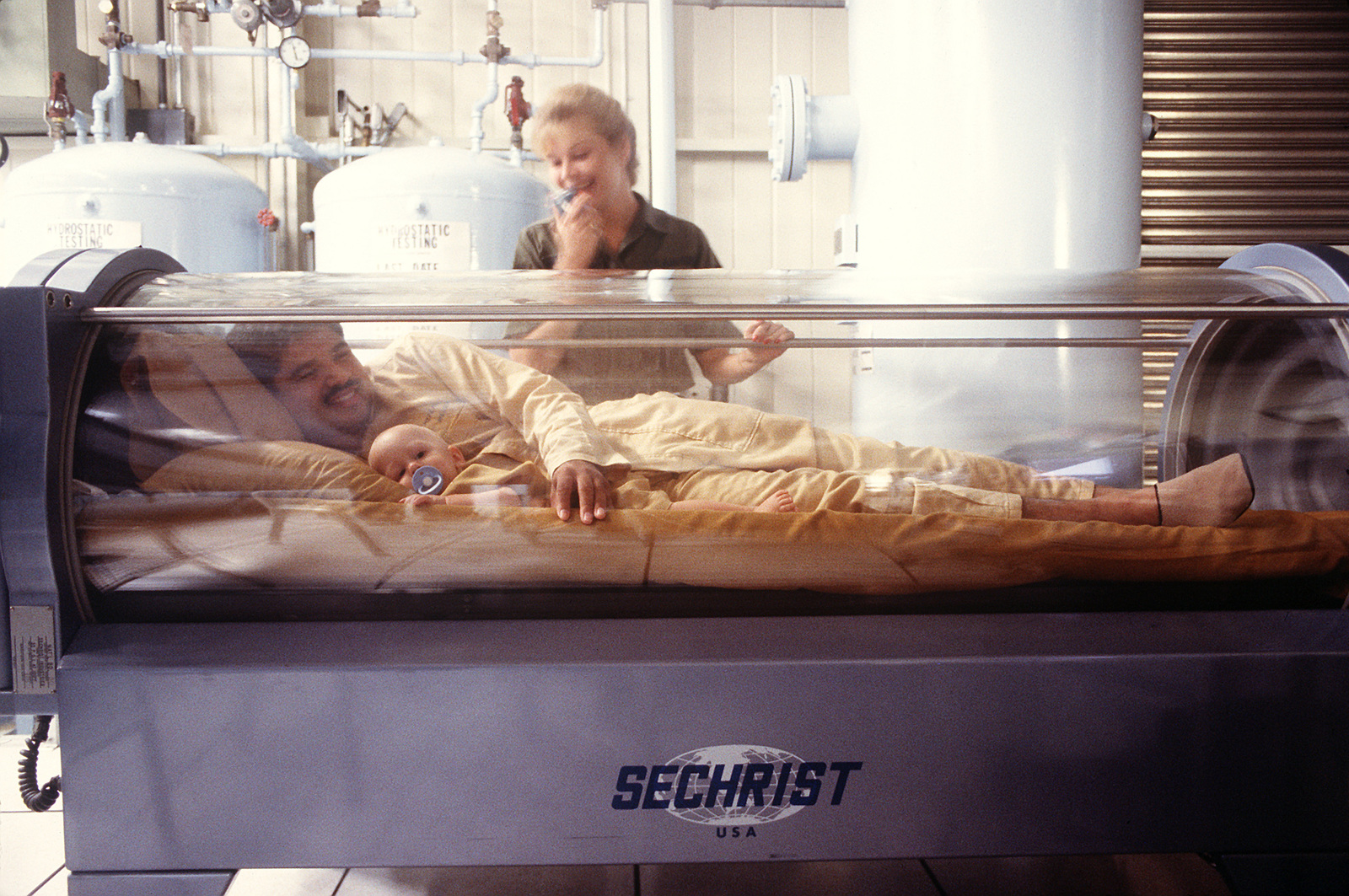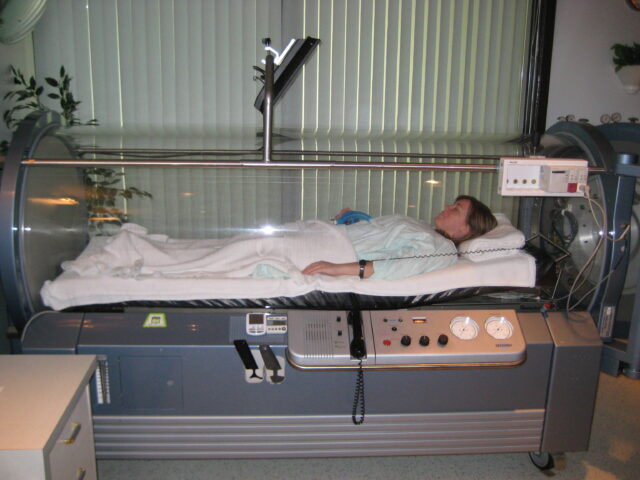Hyperbaric Chamber
Hyperbaric oxygen therapy is an oxygen-sparing treatment for carbon monoxide poisoning, gangrene, stubborn wounds, and infections in which tissues lack oxygen.
The oxygen stress therapy involves breathing in pure oxygen at air pressures 1.5 to 3 times higher than average inside a special chamber. During hyperbaric oxygen therapy, enough oxygen is pumped into the bloodstream to repair tissues and restore normal body functions. In this guide, we’ll discuss the benefits of hyperbaric oxygen therapy, how it works, and precautions you should take.
Types of Hyperbaric oxygen chamber
In hyperbaric oxygen therapy, there are two types of chambers:
- Monoplane chambers. These are chambers designed for one individual. It resembles an MRI machine with its long, plastic tube. The patient lies inside the room. 100% oxygen is slowly pumped into the chamber.
- The Multiplace chamber. More than one person can be accommodated in this room. Most of the treatment is similar. Pure oxygen is breathed through masks or hoods, but people breathe pure air without masks or hoods.
Benefits of Hyperbaric Chamber
Oxygen levels can be increased through a variety of methods. Also included are treatments for Parkinson’s disease, depression, sports injuries, and many more.
1. Improves the condition of the skin
Hyperbaric chambers are also beneficial for your skin. This treatment improves elasticity and leaves patients with glowing skin. Additionally, it is known to:
- Reduce acne
- Reduce scarring
- Reduce hyperpigmentation
- Reduce sagging skin
- Reduce wrinkles
Due to the oxygen feeding cells and stimulating blood flow. This assists in strengthening collagen and detoxifying the skin.
2. Relieves certain types of pain
Furthermore, it lowers the inflammation response in rheumatoid arthritis, Lyme disease, and multiple sclerosis. Because of the reduced inflammation, the patient feels less pain and swelling.
3. Radiation sickness may be lessened
By repairing the vascular system and improving vascular delivery, hyperbaric chambers help. It also helps tissue recover from radiation sickness, so it plays an important role. Radiation causes damage to sensitive cells that are virtually impossible to repair. In that case, sensitive organs lose their strength. When a repaired vascular system is coupled with higher oxygen concentrations, more resources can be available to the healing process.
4. Hyper oxygenating tissues
Hypo oxygenating tissue through HBOT becomes saturated with oxygen, which is known to promote healing. In hyper oxygenated tissues, epithelization occurs, which enlarges the epithelial cells responsible for closing wounds and forming a barrier on the skin. The rate of wound healing can be increased by as much as 69 percent by hyper tissue oxygenation through HBOT. In particular, this is a decisive benefit for diabetic adults who have an increased risk of non-healing wounds.
5. The improved antibacterial capacity of leukocytes
During a treatment such as HBOT, the body is flooded with oxygen, increasing antibacterial activity. A white blood cell, leukocytes, gets its energy and strength from oxygen. Furthermore, they can remove dead cellular debris while killing dangerous bacteria and free radicals. Studies have shown that leukocytes perform best when oxygen levels are above 300 mmHg, which can be achieved only with HBOT.
6. Edema decreased
A condition called edema occurs when tissues or cavities of the body become too swollen with water. Edema can occur anywhere in the brain (cerebral edema) or the lungs (pulmonary edema). Edema increases tissue pressure and reduces circulation, which inhibits wound healing. HBT reduces edema due to its beneficial effect on circulation. Fluids accumulate inside the body and can move throughout the body, filtered and eliminated. Therefore, the injuries are better oxygenated, and the healing process can continue.
Complications and side effects of HBOT

In HBOT, you lie on a table in an enclosed chamber and breathe oxygen while the room’s pressure gradually increases. There may be as little as 3 minutes of therapy or as long as 2 hours before the blood pressure returns to normal. Some people may experience discomfort in the chamber due to the high pressure. Ear pain or a popping sensation may occur. Tiredness and lightheadedness can be possible side effects after HBOT. Serious complications can include:
- Damage to the lungs
- Inflammation of the middle ear (rupture) due to fluid buildup.
- Damage to the sinuses.
- Changes in vision, such as nearsightedness or myopia.
- Oxygen poisoning, which can cause convulsions, fluid in the lungs, or lung failure.
The side effects are usually mild if you:
- The treatment doesn’t last for more than two hours
- The atmospheric pressure inside the chamber is less than three times that of the pressure outside.
Precautions associated with hyperbaric oxygen therapy
Read more: Who Is Nathalie Emmanuel? Nathalie Emmanuel Net Worth, Personal Life, Career And All Other Info
Not everyone should undergo hyperbaric oxygen therapy. Those who have recently had ear surgery or ear trauma, those with a cold or fever, or those with certain types of lung disease should not use it.
Middle ear injuries are the most common complications after HBOT. Sinus problems and eye problems are also possible complications. An individual may suffer from oxygen poisoning in severe cases. Seizures, fluid in the lungs, lung failure, and other complications may result. Considering possible risks and benefits, the decision to undergo hyperbaric oxygen therapy should be carefully considered after detailed discussions with your healthcare provider.
Is a hyperbaric chamber painful?
Hyperbaric oxygen therapy (HBOT) is a medical treatment that involves breathing pure oxygen in a pressurized chamber. It treats various conditions, including decompression sickness, carbon monoxide poisoning, and non-healing wounds. One common question that arises about this treatment is whether or not it is painful.
In general, hyperbaric chambers are not painful. The experience of being inside a hyperbaric chamber is often described as similar to being in an airplane or submarine. As the chamber is pressurized, patients may feel some discomfort in their ears, similar to what one may experience during takeoff or landing. This can be alleviated by swallowing or yawning.
Once the chamber is pressurized, patients typically feel no pain or discomfort. They may feel a sensation of fullness in their ears due to the increased pressure, but this is generally not painful. Some patients may experience mild discomfort or claustrophobia due to the enclosed space, but this can be managed with relaxation techniques or medication if necessary.
In rare cases, some patients may experience discomfort or pain in their sinuses or teeth due to changes in pressure. However, these side effects are generally mild and temporary, and can be managed by adjusting the pressurization rate or administering medication. Overall, hyperbaric chambers are not painful and are a safe and effective treatment for various medical conditions.
FAQs (Frequently Asked Questions)
- What are the health benefits of hyperbaric chambers?
As a result of HBOT, the body’s oxygen radical scavengers are encouraged to seek out the problem molecules and enable healing to proceed. HBOT helps the body’s immune system by blocking the action of harmful bacteria. Some bacteria can have their toxins disabled by HBOT. HBOT also raises the oxygen concentration in the tissues.
- Do you need to use a hyperbaric chamber frequently?
One hyperbaric oxygen chamber therapy session lasts about two hours and takes place once a day, five days a week. If you require more treatment sessions, your doctor can prescribe up to thirty. The number of treatments you receive depends on how quickly your condition improves.
- What is the duration of hyperbaric oxygen therapy’s effects?
However, anyone who needs oxygen treatment should at least commit to a couple of sessions per week at the very least. With one treatment per day for five days, most patients see excellent results, up to 40 treatments total.













